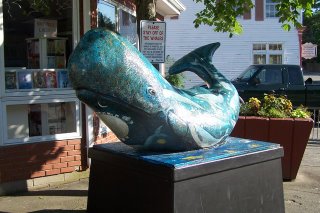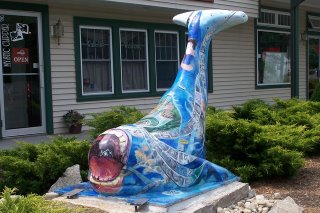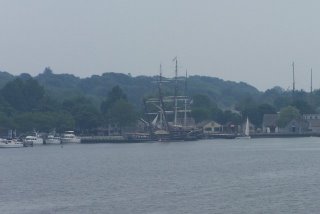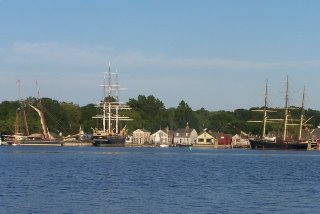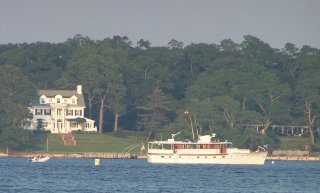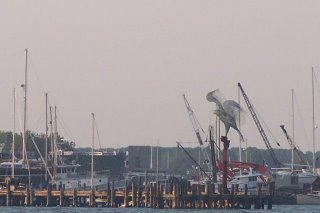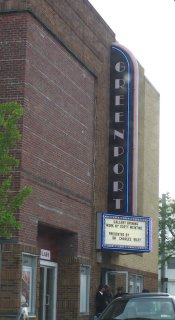
Yet, another rainy day in Rhode Island, but we didn't let that stop us-at least it wasn't as bad as yesterday. Our goal today was Newport, Rhode Island and the Newport Flower show.
As we crossed the Verrazano Bridge, we fell in love with Newport. Before coming here, we were told that even in pre-Revolutionary times that wealthy Southern plantation owners would come to Newport in the summer to escape the heat. The Newport we were seeking was the Newport of turn of the 20th century and the Jazz Age. We weren't disappointed. I took almost 400 pictures today with the constant comment of "Oh my lord!" We saw one opulent mansion after another along Bellvue Avenue and Ocean Drive. I wish I could show you all of them.
Above is an American castle, Rosecliff, the site of the Newport Flower Show. I am quoting here from information about Rosecliff. They tell it better than I ever could.
"Newport's most romantic mansion was built for Tessie Hermann Oelrichs in 1902; her father had amassed a fortune from Nevada silver mines. "Tessie", as she was known to her friends, was born in Virginia City, Nevada. Her father, James Graham Fair, was an Irish immigrant who made an enormous fortune from Nevada's Comstock silver lode, one of the richest silver finds in history. During a summer in Newport, Theresa met Hermann Oelrichs playing tennis at the Newport Casino. They were married in 1890. A year later, they purchased the property known as Rosecliff from the estate of historian and diplomat George Bancroft. An amateur horticulturist, it was Bancroft who developed the American Beauty Rose. The Oelrichs later bought additional property along Bellevue Avenue and commissioned Stanford White to replace the original house with the mansion that became the setting for many of Newport's lavish parties.
Stanford White modeled the palace after the Grand Trianon, the garden retreat of French kings at Versailles, at a reported cost of $2.5 million. Rosecliff has a heart-shape staircase, and Newport's largest private ballroom.
In 1941, the mansion and its contents were sold for $21,000. It was used as a setting for some scenes in the Robert Redford movie of Fitzgerald's The Great Gatsby (1974) and for a ballroom scene in Arnold Schwarzenegger's True Lies (1994)."

"Rosecliff mansion overlooks the Cliffwalk and the Atlantic Ocean. The setting for some of Newport's most lavish parties of the Gilded Age. A tradition that lives on today as Rosecliff mansion still hosts weddings and events all year, including today's Newport Flower Show."
We were so lucky to be here for the Flower Show because in this garden beyond the tents, there was a Jazz combo, providing music to help set the mood for this wonderful party. Mel wouldn't walk to the ocean because the grass was too wet from all the rain, but it was fun to hear the music as we walked through the flower show.

Here is a photo of Newport's harbor with sailboats and the Verazzano Bridge behind it. Those clouds are pea soup fog that hung over the bridge as we arrived and left Newport.
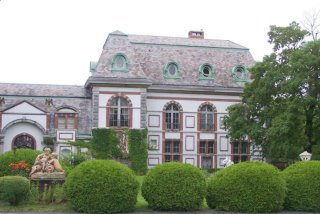

Just as we were about to leave the Cottage area, Mel spotted a sign for a 6 p.m. Candlelight Tour of Belcourt Castle. Above is a photo of the castle. Below is a commentary on the history of the castle.
"Belcourt Castle was constructed for Oliver Hazard Perry Belmont, who inherited a fortune from his father August Belmont, the Rothschild Banking representative in America. His summer cottage incorporated his love for horses and armor, medieval and renaissance architecture within 60-rooms. A bachelor of 36, he had 30 servants - butler, house staff, footmen/stableboys, kitchen staff and groundskeepers - whose aggregate wages were about $100.00 a week for round-the clock service.
As early as 1888, during the Gilded Age Society extravaganzas, Mr. Belmont met Mrs. William Kissam Vanderbilt, wife of his best friend and business partner in several sporting ventures. Alva E. Smith, daughter of an Alabama cotton merchant, was educated in France, married the second son of William H. Vanderbilt and had three children before she divorced Vanderbilt to marry Oliver Belmont in 1895.
After Belmont's death at 50 in 1908, Mrs. Belmont became involved in the Women's movement and actively supported votes for women. She died in 1933, still the owner of Belcourt. Belcourt was sold by the last surviving brother, Perry Belmont, in 1940. It remained unoccupied until 1956, when the present owners, the Tinney Family, purchased the house as a residence. Belcourt Castle soon evolved into a museum as the Tinneys added their fabulous art collection from 33 European and Oriental countries."
"BELCOURT CASTLE is the former summer cottage of Oliver and Alva Belmont, a society couple of the 1890s and 1900s. Oliver commissioned the 60 room chateau-style mansion in 1891, with construction carrying through until 1894. Oliver was mugged in New York City that year and was unable to move in for the 1894 summer season. Belcourt's gothic-mediaeval decor saw no parties, balls or soirees.
Oliver Belmont arrived at Belcourt in July 1895, the beginning of the social season. However, being a bachelor, there were few festivities at Belcourt. That changed after Alva Vanderbilt of Marble House divorced her husband, Oliver's best friend, and soon after (in 1896) married Oliver himself. The couple spent their summers as Belcourt Castle until Oliver's untimely death in 1908, from complications following an appendectomy.
Widowed, Alva Belmont started a renovation project at Belcourt, one that would see Oliver Belmont's dream of living above his stables evolve into an even grander and more eccentric composition of classical European styles, dating from the Renaissance on forward.
After Alva moved to France, Belcourt changed hands many times, first within the Belmont family and then out. The castle became dilapidated and was at risk of demolition until the Harold B. Tinney family purchased the delerict mansion for the price of $25 000. In eight months of ownership, the Tinneys managed not only to greatly improve the castle, but fully furnish it and open it up for tours in July 1957.
Over the years, the Tinney collections and Belcourt have evolved greatly. Guests at Belcourt may enjoy such sights as the Golden Coronation Coach, a Russian imperial chandelier, German throne chairs, stained glass and antiques from thirty-three European and Oriental countries. The notable stained glass collection includes pieces from many different eras and represents the largest private collection of stained glass in the United States."
For my part, this cottage was a bit overdone. I mean, I like opulence as well as the next person but even I, who am over the top most of the time, thought this was too much. The tour guide explained why--because he could. Alva was a bit wacky, too, after Oliver's demise, she undertook a remodeling job that was about as crazy as his thoughts. She was a bit of a witch. Her daughter, who loved another man, was engaged to an English duke with Alva's help. Alva wanted to be associated with royalty. Oliver and Alva deserved each other. However all good things must come to and end, and so this life style fell out of favor with the onset of World War I and the Great Depression. It seems the Vanderbilts, Belmonts, etc. lost their wealth during these hard times. Mel loved the castle-a great place for a Halloween party. I just thought it was creepy!

















